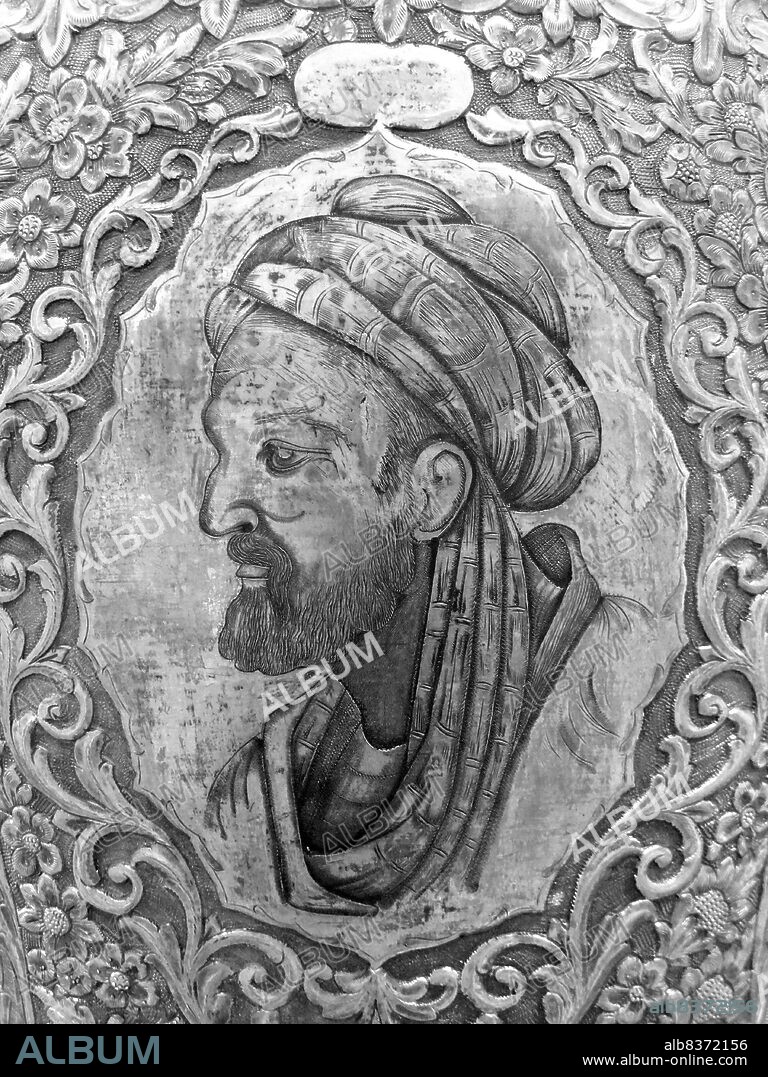alb8372156
Uzbekistan / Iran: Portrait of Avicenna / Ibn Sina impressed on a silver vase, Bu Ali Sina Mausoleum, Hamadan. Photo Adam Jones (CC BY-SA 2.0)

|
Zu einem anderen Lightbox hinzufügen |
|
Zu einem anderen Lightbox hinzufügen |



Haben Sie bereits ein Konto? Anmelden
Sie haben kein Konto? Registrieren
Dieses Bild kaufen

Titel:
Uzbekistan / Iran: Portrait of Avicenna / Ibn Sina impressed on a silver vase, Bu Ali Sina Mausoleum, Hamadan. Photo Adam Jones (CC BY-SA 2.0)
Untertitel:
Siehe automatische Übersetzung
Abu Al al-Husayn ibn Abd Allah ibn Sna (c. 980, Afshana near Bukhara 1037, Hamadan, Iran), commonly known as Ibn Sna or by his Latinized name Avicenna, was a Persian polymath, who wrote almost 450 treatises on a wide range of subjects, of which around 240 have survived. In particular, 150 of his surviving treatises concentrate on philosophy and 40 of them concentrate on medicine.
. His most famous works are The Book of Healing, a vast philosophical and scientific encyclopaedia, and The Canon of Medicine, which was a standard medical text at many medieval universities. The Canon of Medicine was used as a text-book in the universities of Montpellier and Leuven as late as 1650. Ibn Sna's Canon of Medicine provides a complete system of medicine according to the principles of Galen and Hippocrates.
. His corpus also includes writing on philosophy, astronomy, alchemy, geology, psychology, Islamic theology, logic, mathematics, physics, as well as poetry. He is regarded as the most famous and influential polymath of the Islamic Golden Age.
. His most famous works are The Book of Healing, a vast philosophical and scientific encyclopaedia, and The Canon of Medicine, which was a standard medical text at many medieval universities. The Canon of Medicine was used as a text-book in the universities of Montpellier and Leuven as late as 1650. Ibn Sna's Canon of Medicine provides a complete system of medicine according to the principles of Galen and Hippocrates.
. His corpus also includes writing on philosophy, astronomy, alchemy, geology, psychology, Islamic theology, logic, mathematics, physics, as well as poetry. He is regarded as the most famous and influential polymath of the Islamic Golden Age.
Bildnachweis:
Album / Universal Images Group / Pictures From History
Freigaben (Releases):
Model: Nein - Eigentum: Nein
Rechtefragen?
Rechtefragen?
Bildgröße:
3600 x 4800 px | 49.4 MB
Druckgröße:
30.5 x 40.6 cm | 12.0 x 16.0 in (300 dpi)
Schlüsselwörter:
ARZT • DOKTOR • IRAN • ISLAM • KUNST • MEDIZINER • MOHAMMEDANER • MOHAMMEDANERIN • MOSLEM • MOSLEMIN • MUSLIM • MUSLIMIN • MYTHEN: PERSISCH • ORIENTE MEDIO • PERSISCH • PERSISCHE MYTHEN • PERSISCHE • PHYSIK • SILBERSCHMIEDEARBEIT • TECHNIK: SILBERARBEIT • WISSENSCH.: PHYSIK • WISSENSCHAFT • WISSENSCHAFTEN
 Pinterest
Pinterest Twitter
Twitter Facebook
Facebook Link kopieren
Link kopieren Email
Email
